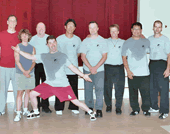

Webmaster's notes: this is an article from our esteemed YiZong board moderator - LeoV.
A Beginner's Journey – How to Learn Baguazhang
By Leo Velasquez
(Author's note: I currently study Gao Style Bagua Zhang with Buddy Tripp (Plymouth, Massachusetts). I would like to publicly thank him for the privilege of walking down the Baguazhang path with him.)
“That looks complicated”
“That looks simple”
“That's a lot of stuff to learn”
“Use my mind?”
“I don't understand”
“That's it? I didn't feel like I did anything.”
These are just some of the statements I've heard from people starting out in Baguazhang. Some of these people were experienced martial artists. Some were new to the whole world of martial arts. Some wanted to fight. Some just wanted to experience better health.
When George Wood prompted (ok, called me out on his discussion board J ) me to contribute an article, my mind started go into overdrive on what to write. There is just so much to the style. There's the body conditioning. Basic movements. Advanced movements. Internal connectivity, fighting strategy, fighting tactics, etc., etc. etc. Whoa! Where to start!?!?!
I credit the Gao Style system, my teacher, my fellow senior and junior Gao family members, and of course Luo Laoshi for this dilemma. Do not misinterpret my words: it is not a bad thing that there's a vastness to the system. It is a good thing.
Which led me to the topic of the article. This thinking of what to write drew me back to my days when I first started in Baguazhang. Those statements I listed at the top where ones I experienced, and happy to report, still experience.
I like working with people starting out in the system, as it gives me a chance to share, and hopefully mold, people's experience with Baguazhang.
For the beginner starting out in Baguazhang it can be a daunting task. Watching a video or seeing Luo Laoshi one would think, “That looks easy. I can do it.” Reality teaches us, though, that there is a lot to learn before even approaching the application of Baguazhang.
So what's a beginner to do?
Learn to Observe and Listen
Yes, these are skills to master. People can watch a technique, but it's usually like how they watch television or a movie, which is disconnected. By this I mean the person is watching, but their mind is not in the moment.
You want to learn to observe . Where is their feet? How did they take space? How did they do the opening? What is the principle of the technique? Learning to observe, I believe, is the first step towards developing intent. If your mind is not on the moment, how can you learn, or later down the path, apply intent?
With observation comes listening. Not all lessons are demonstrated. Some are discussed. I've seen examples of when a senior is talking that others are not listening. There are great lessons that are being relayed and missed by simply not listening. And that's too bad. Sometimes the greatest lessons are in those discussions and not in the physical training.
Ask Questions
If you don't understand, ask questions. Asking questions helps not only the person asking the questions, but the instructor and your seniors. Why? Your questions that you ask your instructor and seniors can judge where you are at with a particular movement/concept. Also it may indicate that you see something in a different way than others, which is not a bad thing.
Part of this though, goes back to listening. Listen to the answer before shooting off another question. Too many times people (not just beginners) are thinking about the next question they are going to ask while an answer is being given.
Take Notes
Learn to take notes. As I stated earlier, Baguazhang is a very deep and vast system. You are not going to memorize everything the first time you see it. You need to take notes.
Set up a system where you can easily add to the topics. I recommend utilizing a loose leaf binder, where you can sort notes and add pages easily. Also carry a small notebook with you to class and to seminars.
You will also need to develop your own system of shorthand. It is impossible to write word for word what is going on. Doodles, shorthand, code words – all legitimate as long as you can understand your notes. It's not important that others understand it, just you.
Review your notes shortly after the class or seminar. It will help you understand your notes later (a month, year, 2 years from now).
That brings up another point: Do not depend on others to take notes for you! I guarantee that you will not understand what they wrote or be able to interpret their “chicken scratch”. Also the note-taker will write down what is important to them, and miss the one concept you need. Murphy's law always kicks in when you do not want it to.
Bottom line: Don't be afraid to write things down!
Practice
Want to learn Baguazhang? Here's the secret: Practice every day . Practice something. Basics, changes, line work, what ever – work on something.
Do not just go through the motions, make it quality practice. 10 good movements is better than 100 bad movements.
Next step? Practice some more .
Third step? You have it: keep practicing .
Like any skill you want to obtain and master, you need to work at it. There are very, very few of us (if any) that are gifted and can learn this art just at class. You need to practice. You need to work a principle again and again. You need to work a technique again and again. You need to work a basic again and again.
Anything worthwhile in life is worth working towards. You owe it to your teacher and fellow school mates. They have invested time in you. You need to prove that it was not a waste of time and that you've listened and that you're climbing the same path that they did.
To modify one of George Wood's sayings, “Your seniors are on the same path as you. A little further down the path, but the same path nevertheless.” Prove to them that you're willing to travel the same path as they did. It will be time well spent.
Enjoy the Journey
Have fun with this art.
Do not rush down the path. Smell the roses.
People learn things at different paces, so do not worry about how you compare to others. Some skills you will easily pick up, some not. Others will take forever to learn a skill you picked up quickly, while quickly learning a skill that taking you forever to learn.
You have only yourself to master. And ultimately that is the goal, so enjoy the ride while it lasts.
